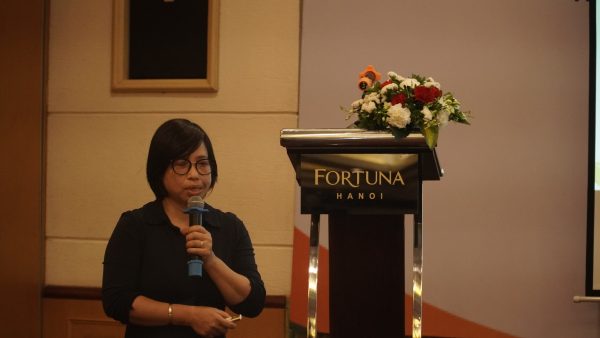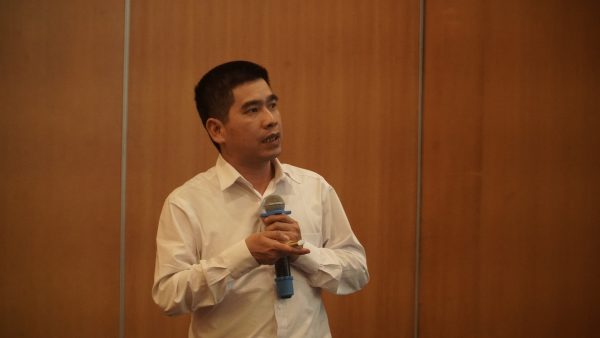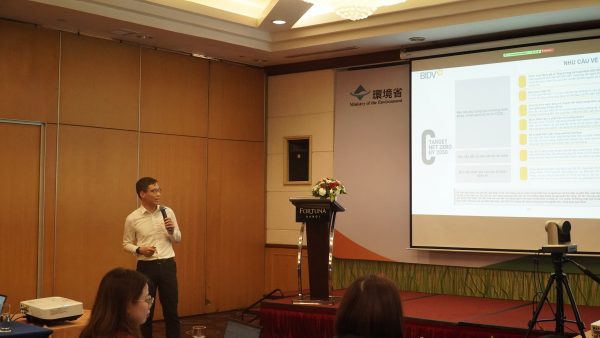On the afternoon of March 25, 2025 in Hanoi, the technical meeting titled “Promoting green finance towards net zero emissions in Vietnam” was successfully held. The event was organized by Energy and Environmental Consultancy Joint Stock Company (VNEEC), in collaboration with the Center for Climate Change Adaptation and Carbon Neutrality and PoA Carbon Vietnam Management Joint Stock Company. It was sponsored by the Partnership to Strengthen Transparency for Co-Innovation (PaSTI), the Ministry of the Environment of Japan, and implemented through the Overseas Environmental Cooperation Center, Japan (OECC). The meeting aimed to share the latest trends and updates on green finance within an international framework while providing information related to the legal framework, institutional structures, and national context of green finance in Vietnam.

(Photo: Mr. Ha Quang Anh, Director of the Center for Climate Change Adaptation and Carbon Neutrality, Department of Climate change, Ministry of Agriculture and Environment)
In his opening remarks, Mr. Ha Quang Anh, Director of the Center for Climate Change Adaptation and Carbon Neutrality under the Department of Climate Change (Ministry of Agriculture and Environment), emphasized that the goal of net zero emissions by 2050 is not only Vietnam’s commitment but also an inevitable trend in global trade and investment. To achieve this goal, Vietnam faces significant financial demands, in which green finance plays a crucial role in promoting low-carbon emission targets and supporting the transition of high-emission sectors toward net zero
As Vietnam gradually strengthens its legal and institutional framework for promoting green finance, Ms. Dang Hong Hanh, Co-founder and CEO of VNEEC, stressed the urgent need for financial resources to implement greenhouse gas (GHG) emission reduction targets. According to the updated Nationally Determined Contributions (NDC 2022) submitted to the United Nations Framework Convention on Climate Change (UNFCCC) Secretariat in November 2022, Vietnam requires around USD 21.7 billion to achieve a 15.8% emissions reduction by 2030 compared to the business-as-usual (BAU) scenario using domestic resources (equivalent to 146.3 million tons of CO₂e). To further reduce this to 43.5% (403.7 million tons of CO₂e), Vietnam needs to raise about USD 86.8 billion from international financial sources, including grants, concessional loans, technology support, and capacity building.
International experiences show that many countries have established clear green finance regulatory frameworks with specialized coordinating agencies and transparent mechanisms. For example: China issued the “Guidelines for Establishing a Green Financial System” (2016) and the “Catalogue of Green Industry Guidance” (2019); Japan implemented the “Sustainable Finance Strategy” (2021–2022); Singapore launched its “Green Finance Action Plan” (2019). These countries have also established leading institutions such as the People’s Bank of China, the Financial Services Agency of Japan, and the Monetary Authority of Singapore. Moreover, strong green finance taxonomies have been developed, such as China’s Green Bond Endorsed Project Catalogue (2021) and the Singapore-Asia Taxonomy for Sustainable Finance (2023).
Vietnam is also making significant strides in developing green finance policies, with various relevant regulations included in the Law on Environmental Protection, the Investment Law, and long-term development strategies. The State Bank of Vietnam plays a key role in setting green credit standards and managing environmental risks in financial activities. However, the domestic green finance market is still in its early stages and faces challenges such as limited funding sources, lack of specialized financial products, and barriers to accessing green capital.

(Photo: Ms. Dang Hong Hanh – Co-founder, CEO VNEEC)
Currently, two main green financial instruments, green credit and green bonds, are regulated under the Environmental Protection Law. According to Mr. Lai Van Manh, an expert from the Institute of Policy and Strategy for Agriculture and Environment (Ministry of Agriculture and Environment), green credit refers to loans provided by credit institutions for consumption, investment, or business activities that have no negative impact to the environment, thereby contributing to the protection and preservation of ecosystems. Meanwhile, green bonds are a means of raising capital issued by the state, local authorities, or enterprises to support green projects. Both are considered green loans that finance projects delivering clear environmental benefits. At present, the Institute of Policy and Strategy for Agriculture and Environment is developing a green taxonomy. The current draft classifies investment projects into eight major categories: energy, transportation, construction, water resources, agriculture – forestry – fisheries, biodiversity, manufacturing, and environmental services.

(Photo: Mr. Lai Van Manh, expert at the Institute of Policy and Strategy for Agriculture and Environment, Ministry of Agriculture and Rural Development)
Mr. Trinh Quynh Thanh, Deputy Director of Currency and Capital Business Division at Joint Stock Commercial Bank for Investment and Development of Vietnam (BIDV), emphasized the growing demand for green finance among businesses in Vietnam, especially as the country promotes green growth strategies and emissions reduction commitments. As of 2024, BIDV’s outstanding green loans accounted for 4.09% of its total, a 7.2% increase compared to 2023. Enterprises are becoming more engaged with renewable energy projects, green buildings, sustainable transportation, and are seeking appropriate financial solutions such as green bonds and green loans. Many international financial institutions are also actively engaging in this market, requiring businesses to adopt transition strategies to meet ESG standards.

(Photo: Mr. Trinh Quynh Thanh, Deputy Director of Currency and Capital Business Division, BIDV)
BIDV has pioneered the issuance of green deposits, green bonds, and sustainable bonds with a total value of trillions of VND, attracting considerable interest from international investors. However, promoting green finance still faces challenges due to an underdeveloped legal framework of green taxonomy in Vietnam, lack of project effectiveness evaluation methods as well as concerns about high transition costs and profitability of green financial products. To address these challenges, BIDV has proposed several key solutions such as the prompt issuance of a green taxonomy, preferential mechanisms for interest rates, taxes, and fees for green credit and green businesses. At the same time, enterprises should proactively connect with international financial institutions, bring in ODA and FDI into sustainable projects, and enhance ESG-related capabilities.
The technical meeting “Promoting green finance towards net zero emissions in Vietnam” provided practical and updated insights into green finance trends, policies, and instruments. The event served as a forum for stakeholders to exchange ideas, contributing to the development of mechanisms and legal frameworks suited to Vietnam’s national conditions. Discussions from the meeting are expected to continue to spread and support Vietnam on its path to fulfilling climate commitments and achieving net zero emissions by 2050.
Media coverage of the event (continuously updated):
- Vietnam Economic News https://congthuong.vn/tai-chinh-xanh-co-hoi-nao-cho-phat-thai-rong-bang-0-379943.html?gidzl=H3grIEK24W15BRPCv1yK14GekKd_6nm4NNkm7laR45TVVx0RyqqNLLyguHhyJKrJ2ddi766L0PLxumWH0m
- Vietnam Agriculture Newspaper: https://nongnghiep.vn/phan-loai-du-an-xanh-giup-phat-huy-hieu-qua-tai-chinh-xanh-d744878.html
2,199 views, 10

Tags:
Bài viết liên quan